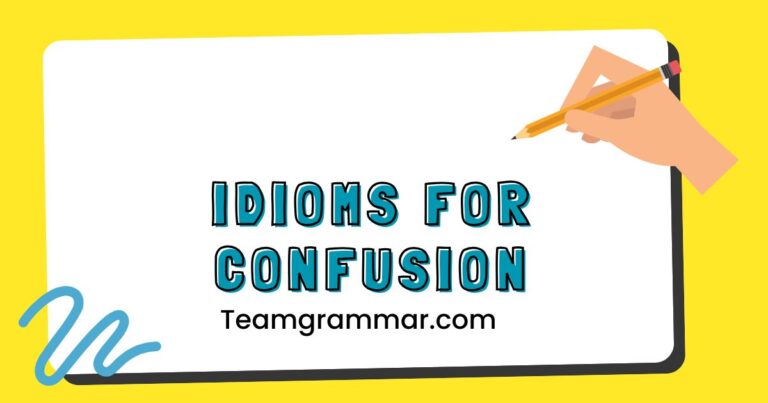45 Idioms for “Slow”: A Comprehensive Guide to English Expressions
Understanding idioms is crucial for mastering English, as they add color and nuance to everyday conversations and writing. This article focuses on idioms that describe slowness, whether in terms of speed, comprehension, or progress.
By exploring these expressions, learners can enhance their vocabulary, improve their comprehension of native English speakers, and communicate more effectively. This guide is perfect for English language learners of all levels, from beginners looking to expand their knowledge to advanced speakers aiming to refine their understanding of idiomatic language.
Table of Contents
- Introduction
- Definition of Idioms for “Slow”
- Structural Breakdown of Idioms
- Types and Categories of “Slow” Idioms
- Examples of “Slow” Idioms
- Usage Rules for “Slow” Idioms
- Common Mistakes with “Slow” Idioms
- Practice Exercises
- Advanced Topics: Nuances and Regional Variations
- Frequently Asked Questions
- Conclusion
Introduction
Idioms are phrases or expressions whose meanings cannot be understood from the literal definitions of the individual words. They are a vital part of any language, adding richness and depth to communication.
In English, there are numerous idioms to describe the concept of “slow,” whether referring to physical speed, mental processing, or the pace of progress. Understanding these idioms is essential for both comprehension and effective communication.
This article aims to provide a comprehensive overview of idioms related to “slow,” offering definitions, examples, and practical guidance on their correct usage.
Definition of Idioms for “Slow”
An idiom for “slow” is a phrase or expression that conveys the idea of something moving, progressing, or understanding at a reduced pace. Unlike literal expressions, the meaning of an idiom is figurative and often culturally specific.
These idioms can describe physical slowness, mental slowness, or the slow advancement of a project or situation. The key characteristic of an idiom is that its combined meaning is different from the literal meanings of its constituent words.
Recognizing and using idioms correctly is a sign of advanced language proficiency.
Classification of “Slow” Idioms
Idioms for “slow” can be classified based on the specific aspect of slowness they describe. This can include:
- Speed: Describing the physical slowness of movement or action.
- Comprehension: Describing the slowness of understanding or mental processing.
- Progress: Describing the slow advancement of a project, situation, or development.
- Reaction: Describing the slowness of response or reaction time.
Function of “Slow” Idioms
The function of using idioms for “slow” is to add color and expressiveness to language. Instead of simply stating that something is slow, an idiom can convey a more nuanced or vivid picture.
This can enhance communication by making it more engaging and relatable. Idioms also serve to connect speakers within a cultural context, as their usage demonstrates familiarity with the language’s subtleties.
Contexts for Using “Slow” Idioms
Idioms for “slow” can be used in various contexts, from casual conversations to formal writing. However, it’s important to consider the audience and the tone of the communication.
In informal settings, a wide range of idioms can be appropriate. In more formal settings, it’s often best to choose idioms that are widely understood and avoid those that are too colloquial or obscure.
Consider the following contexts:
- Informal conversations: Everyday discussions with friends, family, or colleagues.
- Formal presentations: Business meetings, academic lectures, or public speeches.
- Written communication: Emails, reports, articles, or creative writing.
Structural Breakdown of Idioms
Idioms often have a fixed structure, meaning the words and their order cannot be changed without altering the meaning or making the expression nonsensical. The structure can involve various grammatical elements, such as verbs, nouns, adjectives, and prepositions.
Understanding the structural elements helps in recognizing and using idioms correctly.
Many idioms follow specific patterns. For example, some idioms use similes (comparisons using “like” or “as”) to describe slowness.
Others may use metaphors (implied comparisons) to convey the same idea. Recognizing these patterns can aid in understanding and remembering idioms.
Types and Categories of “Slow” Idioms
Idioms for “slow” can be categorized based on the type of slowness they describe. This includes idioms related to speed, comprehension, progress, and reaction time.
Each category has its own set of expressions with unique nuances and connotations.
Idioms Describing Slow Speed
These idioms refer to the physical slowness of movement or action. They can describe a person who is moving slowly, a vehicle that is not going fast, or any other situation where speed is reduced.
The table below provides examples of idioms describing slow speed, along with their meanings and example sentences.
| Idiom | Meaning | Example Sentence |
|---|---|---|
| At a snail’s pace | Very slowly | The traffic was moving at a snail’s pace due to the accident. |
| In slow motion | Moving very slowly, as if replayed in slow motion | The runner felt like he was running in slow motion as he approached the finish line. |
| Like molasses in January | Extremely slow (often used in cold climates) | Trying to get anything done in this office is like molasses in January. |
| Slow as a turtle | Very slow | He’s as slow as a turtle when it comes to getting ready in the morning. |
| Dragging one’s feet | Being deliberately slow or reluctant | The company is dragging its feet on implementing the new safety regulations. |
| Going nowhere fast | Making little or no progress | We’re working hard, but it feels like we’re going nowhere fast. |
| One step forward, two steps back | Making progress but then regressing | The project seems to be one step forward, two steps back. |
| Taking its time | Proceeding slowly and deliberately | The software update is taking its time to install. |
| Slow off the mark | Slow to start or react | He’s a bit slow off the mark in the mornings. |
| Behind the curve | Lacking current knowledge or understanding; falling behind | If you don’t keep up with technology, you’ll quickly fall behind the curve. |
| Crawling | Moving extremely slowly | The traffic was crawling due to the heavy rain. |
| Creeping | Moving slowly and stealthily | The fog was creeping in from the sea. |
| Leisurely pace | Moving at a relaxed and unhurried speed | We took a leisurely pace through the park. |
| Lumbering | Moving in a slow, heavy, awkward way | The elephant was lumbering across the field. |
| Plodding | Moving slowly and with effort | He was plodding through the snow. |
| Staggering | Moving unsteadily and slowly | After the accident, he was staggering around in a daze. |
| Dawdling | Wasting time; moving slowly and aimlessly | The children were dawdling on their way to school. |
| Lingering | Staying longer than necessary; moving slowly | The smell of coffee was lingering in the air. |
| Tarrying | Delaying or lingering; moving slowly | They were tarrying in the garden, enjoying the sunshine. |
| Puttering | Working or moving about in a leisurely or ineffective way | He was puttering around in the garage. |
| Inch along | To move very slowly | The car inched along the crowded highway. |
| At a dead slow | Moving at the slowest possible speed | The train was moving at a dead slow as it approached the station. |
| Moving at a snail’s gallop | An oxymoron, emphasizing extreme slowness | The project was moving at a snail’s gallop. |
| Slow burn | Something that develops slowly over time | The movie was a slow burn, but ultimately very rewarding. |
Idioms Describing Slow Comprehension
These idioms refer to the slowness of understanding or mental processing. They can describe someone who is slow to understand, a concept that is difficult to grasp, or a situation where mental agility is lacking.
The table below provides examples of idioms describing slow comprehension, along with their meanings and example sentences.
| Idiom | Meaning | Example Sentence |
|---|---|---|
| Slow on the uptake | Slow to understand or realize something | He’s a nice guy, but he’s a little slow on the uptake. |
| A bit thick | Not very intelligent or quick to understand | I tried to explain it to him, but he’s a bit thick. |
| Not the sharpest tool in the shed | Not very intelligent | He’s not the sharpest tool in the shed, but he’s a hard worker. |
| Dense | Slow to understand; stupid | Sometimes I feel like I’m talking to a brick wall; he’s so dense. |
| Dim-witted | Stupid or unintelligent | He’s a bit dim-witted, but he means well. |
| Not playing with a full deck | Not very intelligent or sane | I think he’s not playing with a full deck. |
| One sandwich short of a picnic | Not very intelligent | He’s one sandwich short of a picnic, if you ask me. |
| Brain is in neutral | Not thinking clearly or actively | My brain is in neutral this morning; I can’t seem to focus. |
| Asleep at the wheel | Not paying attention or being alert | The manager was asleep at the wheel when the crisis hit. |
| Out to lunch | Not paying attention or being unaware of what’s happening | He’s completely out to lunch today. |
| A few bricks short of a load | Not very intelligent | I think he’s a few bricks short of a load. |
| The lights are on, but nobody’s home | Appearing to be present but not thinking clearly | He just stares blankly; it’s like the lights are on, but nobody’s home. |
| Not all there | Slightly mentally impaired or not fully alert | She hasn’t been quite all there since the accident. |
| A little slow | Not very quick-witted or intelligent | He’s a little slow, but he’s a good person. |
| Takes a while to dawn | Takes a long time to understand or realize something | It took a while for the truth to dawn on him. |
| Not grasping at straws | Not understanding something obvious (often used ironically) | He’s really not grasping at straws, is he? |
| Having a senior moment | Experiencing a temporary lapse in memory or cognitive function | I’m having a senior moment; I can’t remember where I put my keys. |
| Lost for words | Unable to think of anything to say, often due to surprise or confusion | I was lost for words when I heard the news. |
| Brain fart | A temporary mental lapse or failure to recall something | I had a total brain fart and couldn’t remember her name. |
| Thick as two short planks | Very unintelligent | He’s as thick as two short planks, bless him. |
| Couldn’t organize a piss-up in a brewery | Extremely incompetent, especially in organizing things | He couldn’t organize a piss-up in a brewery. |
| Operating at half-mast | Not functioning at full capacity, either mentally or physically | I’m operating at half-mast today because I didn’t get enough sleep. |
| A few cards short of a deck | Not very intelligent or mentally sound | I think he’s a few cards short of a deck. |
Idioms Describing Slow Progress
These idioms refer to the slow advancement of a project, situation, or development. They can describe a task that is taking a long time to complete, a situation that is not improving, or a process that is moving at a reduced pace.
The table below provides examples of idioms describing slow progress, along with their meanings and example sentences.
| Idiom | Meaning | Example Sentence |
|---|---|---|
| Moving at a glacial pace | Extremely slow progress | The negotiations are moving at a glacial pace. |
| Stuck in the mud | Unable to make progress | The project is stuck in the mud due to lack of funding. |
| Bogged down | Slowed down or prevented from making progress | We’re bogged down in paperwork. |
| Spinning one’s wheels | Expending effort without making progress | I feel like I’m just spinning my wheels at this job. |
| Dragging on | Continuing for too long | The meeting is dragging on and on. |
| In the doldrums | In a state of inactivity or stagnation | The economy is in the doldrums. |
| Treading water | Making no progress | We’re just treading water until the new manager arrives. |
| A long haul | A long and difficult process | Getting this company back on its feet will be a long haul. |
| Not getting anywhere | Making no progress | We’re not getting anywhere with this discussion. |
| Slogging away | Working hard but making slow progress | He’s been slogging away at his dissertation for months. |
| Taking forever | Taking a very long time | This project is taking forever to complete. |
| A never-ending story | Something that seems to go on and on without resolution | The legal battle has become a never-ending story. |
| Long time coming | Something that has been expected or desired for a long time | The victory was a long time coming. |
| Slow and steady wins the race | Consistent effort leads to success, even if progress is slow | Remember, slow and steady wins the race. |
| Rome wasn’t built in a day | Important projects take time and effort | We can’t expect to finish this project overnight; Rome wasn’t built in a day. |
| Like watching paint dry | Extremely boring or slow | Watching him work is like watching paint dry. |
| Like watching grass grow | Extremely boring or slow | Waiting for the decision is like watching grass grow. |
| At a standstill | A situation in which all activity or progress has stopped | The negotiations are at a standstill. |
| Back to square one | Having to start something again because a previous attempt failed | The deal fell through, so we’re back to square one. |
| Up against it | Facing difficulties or making slow progress | We’re really up against it with this deadline. |
| Get the ball rolling | To start something, especially a project or activity | Let’s get the ball rolling on this project. |
| Gain traction | To start to make progress or become popular | The campaign is finally starting to gain traction. |
Usage Rules for “Slow” Idioms
Using idioms correctly requires understanding their specific meanings and contexts. While many idioms can be used interchangeably, some have subtle differences in connotation or formality.
Here are some general rules to follow:
- Understand the meaning: Make sure you fully understand the meaning of the idiom before using it.
- Consider the context: Choose idioms that are appropriate for the situation and audience.
- Use them sparingly: Overusing idioms can make your language sound unnatural or forced.
- Be aware of regional variations: Some idioms are more common in certain regions or dialects.
Some idioms have specific grammatical requirements. For example, some idioms require a particular verb tense or preposition.
Pay attention to these requirements to avoid making grammatical errors.
Common Mistakes with “Slow” Idioms
One common mistake is using idioms out of context. For example, using a very informal idiom in a formal presentation can be inappropriate.
Another common mistake is misunderstanding the meaning of an idiom and using it incorrectly.
Sometimes, learners may try to create their own idioms by combining elements of different expressions. This usually results in nonsensical or confusing phrases.
It’s best to stick to established idioms and use them correctly.
Here are some examples of common mistakes and their corrections:
| Incorrect | Correct | Explanation |
|---|---|---|
| He is slow on the take. | He is slow on the uptake. | “Uptake” is the correct word in this idiom, referring to understanding. |
| The project is stuck in a mud. | The project is stuck in the mud. | The idiom is “stuck in the mud,” not “stuck in a mud.” |
| They are dragging their feets. | They are dragging their feet. | “Feet” is already plural, so it doesn’t need an additional “s.” |
| He’s not the sharpest knife in the drawer. | He’s not the sharpest tool in the shed. | The correct idiom is “tool in the shed,” not “knife in the drawer.” |
Practice Exercises
Test your understanding of idioms for “slow” with the following exercises. Choose the correct idiom to complete each sentence.
| Question | Options | Answer |
|---|---|---|
| The traffic was moving _________ due to the accident. | a) at a snail’s pace, b) at a bird’s speed, c) at a cheetah’s rate | a) at a snail’s pace |
| He’s a nice guy, but he’s a little _________. | a) fast on the uptake, b) slow on the uptake, c) quick on the uptake | b) slow on the uptake |
| The negotiations are moving at a _________. | a) speedy pace, b) glacial pace, c) rapid pace | b) glacial pace |
| I feel like I’m just _________ at this job. | a) spinning my wheels, b) turning my tires, c) rotating my cogs | a) spinning my wheels |
| This project is _________ to complete. | a) taking shortly, b) taking briefly, c) taking forever | c) taking forever |
| The manager was _________ when the crisis hit. | a) awake at the wheel, b) asleep at the wheel, c) alert at the wheel | b) asleep at the wheel |
| Getting this company back on its feet will be _________. | a) a short run, b) a long haul, c) a quick sprint | b) a long haul |
| We can’t expect to finish this project overnight; _________. | a) London wasn’t built in a day, b) Paris wasn’t built in a day, c) Rome wasn’t built in a day | c) Rome wasn’t built in a day |
| He’s _________, but he’s a hard worker. | a) the sharpest tool in the shed, b) not the sharpest tool in the shed, c) the dullest tool in the shed | b) not the sharpest tool in the shed |
| The software update is _________ to install. | a) rushing its time, b) taking its time, c) hurrying its time | b) taking its time |
Exercise 2: Fill in the blanks with the correct idiom.
| Question | Answer |
|---|---|
| He’s _________ when it comes to getting ready in the morning. | slow as a turtle |
| Trying to get anything done in this office is _________. | like molasses in January |
| The company is _________ on implementing the new safety regulations. | dragging its feet |
| The project seems to be _________. | one step forward, two steps back |
| He’s a bit _________, but he means well. | dim-witted |
| I think he’s _________. | not playing with a full deck |
| My brain is _________ this morning; I can’t seem to focus. | in neutral |
| We’re just _________ until the new manager arrives. | treading water |
| He’s been _________ at his dissertation for months. | slogging away |
| The victory was _________. | a long time coming |
Advanced Topics: Nuances and Regional Variations
Some idioms have subtle nuances that can only be understood through extensive exposure to the language. For example, the idiom “slow burn” can refer to something that develops slowly and intensely, while “slow and steady wins the race” emphasizes the importance of perseverance.
Idioms can also vary significantly between different regions or dialects. An idiom that is common in American English may be completely unknown in British English, and vice versa.
It’s important to be aware of these regional variations and use idioms that are appropriate for your audience.
For instance, the phrase “thick as mince” is a British idiom meaning unintelligent, whereas “dense” might be more common in American English to express the same concept.
Frequently Asked Questions
- What is an idiom?
An idiom is a phrase or expression whose meaning cannot be understood from the literal definitions of the individual words. It’s a figurative expression that has a specific meaning known to native speakers of the language.
- Why is it important to learn idioms?
Learning idioms is important for improving your understanding of spoken and written English. It allows you to comprehend native speakers more effectively and communicate in a more natural and expressive way. Idioms also provide insights into the culture and history of the language.
- How can I learn idioms effectively?
To learn idioms effectively, start by reading and listening to a lot of English content. Pay attention to the context in which idioms are used and try to understand their meanings. Use flashcards or other mnemonic devices to memorize idioms, and practice using them in your own conversations and writing.
- Are idioms the same in all English-speaking countries?
No, idioms can vary significantly between different English-speaking countries and regions. Some idioms are common to all English speakers, while others are specific to a particular region or dialect. Be aware of these regional variations and use idioms that are appropriate for your audience.
- Can I create my own idioms?
While it’s possible to create new expressions, it’s generally best to stick to established idioms that are widely understood. Creating your own idioms can lead to confusion or misunderstanding.
- What should I do if I don’t understand an idiom?
If you don’t understand an idiom, try to look it up in a dictionary or online resource. You can also ask a native speaker to explain it to you. Pay attention to the context in which the idiom is used, as this can often provide clues to its meaning.
- Is it okay to use idioms in formal writing?
The appropriateness of using idioms in formal writing depends on the specific idiom and the overall tone of the writing. Some idioms are widely understood and can be used in formal contexts, while others are too colloquial or obscure. Use your judgment and consider your audience when deciding whether to use idioms in formal writing.
- How do I avoid misusing idioms?
To avoid misusing idioms, always double-check their meaning and usage before using them. Pay attention to the grammatical requirements of the idiom and make sure you are using it in the correct context. If you are unsure about an idiom, it’s best to avoid using it altogether.
- Are there any resources that can help me learn idioms?
Yes, there are many resources available to help you learn idioms. These include dictionaries, online resources, textbooks, and language learning apps. Look for resources that provide definitions, examples, and practice exercises.
Conclusion
Mastering idioms for “slow” can significantly enhance your English language skills. By understanding and using these expressions correctly, you can communicate more effectively and engage with native speakers on a deeper level.
Remember to focus on understanding the meanings of idioms, considering the context in which they are used, and being aware of regional variations. Continue to practice and expand your knowledge, and you’ll find that idioms become an invaluable tool in your English language journey.
Embrace the challenge and enjoy the richness and expressiveness that idioms bring to the language.







